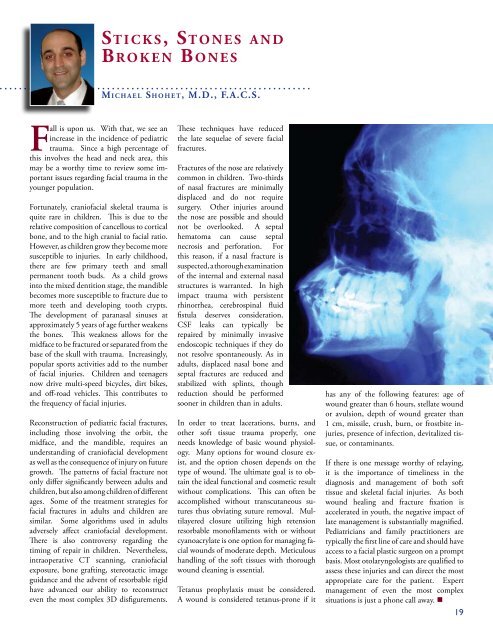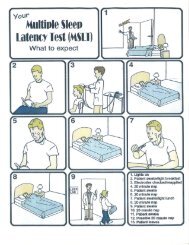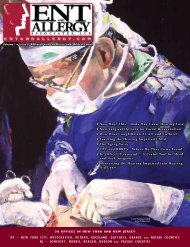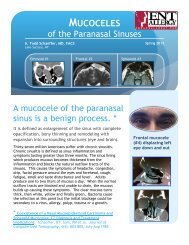A Royal Pain in the Throat Tinnitus - ENT & Allergy Associates
A Royal Pain in the Throat Tinnitus - ENT & Allergy Associates
A Royal Pain in the Throat Tinnitus - ENT & Allergy Associates
- No tags were found...
You also want an ePaper? Increase the reach of your titles
YUMPU automatically turns print PDFs into web optimized ePapers that Google loves.
St i c k s , St o n e s a n dB r o k e n Bo n e sM i c h a e l Sh o h e t , M.D., F.A.C.S.Fall is upon us. With that, we see an<strong>in</strong>crease <strong>in</strong> <strong>the</strong> <strong>in</strong>cidence of pediatrictrauma. S<strong>in</strong>ce a high percentage ofthis <strong>in</strong>volves <strong>the</strong> head and neck area, thismay be a worthy time to review some importantissues regard<strong>in</strong>g facial trauma <strong>in</strong> <strong>the</strong>younger population.Fortunately, craniofacial skeletal trauma isquite rare <strong>in</strong> children. This is due to <strong>the</strong>relative composition of cancellous to corticalbone, and to <strong>the</strong> high cranial to facial ratio.However, as children grow <strong>the</strong>y become moresusceptible to <strong>in</strong>juries. In early childhood,<strong>the</strong>re are few primary teeth and smallpermanent tooth buds. As a child grows<strong>in</strong>to <strong>the</strong> mixed dentition stage, <strong>the</strong> mandiblebecomes more susceptible to fracture due tomore teeth and develop<strong>in</strong>g tooth crypts.The development of paranasal s<strong>in</strong>uses atapproximately 5 years of age fur<strong>the</strong>r weakens<strong>the</strong> bones. This weakness allows for <strong>the</strong>midface to be fractured or separated from <strong>the</strong>base of <strong>the</strong> skull with trauma. Increas<strong>in</strong>gly,popular sports activities add to <strong>the</strong> numberof facial <strong>in</strong>juries. Children and teenagersnow drive multi-speed bicycles, dirt bikes,and off-road vehicles. This contributes to<strong>the</strong> frequency of facial <strong>in</strong>juries.Reconstruction of pediatric facial fractures,<strong>in</strong>clud<strong>in</strong>g those <strong>in</strong>volv<strong>in</strong>g <strong>the</strong> orbit, <strong>the</strong>midface, and <strong>the</strong> mandible, requires anunderstand<strong>in</strong>g of craniofacial developmentas well as <strong>the</strong> consequence of <strong>in</strong>jury on futuregrowth. The patterns of facial fracture notonly differ significantly between adults andchildren, but also among children of differentages. Some of <strong>the</strong> treatment strategies forfacial fractures <strong>in</strong> adults and children aresimilar. Some algorithms used <strong>in</strong> adultsadversely affect craniofacial development.There is also controversy regard<strong>in</strong>g <strong>the</strong>tim<strong>in</strong>g of repair <strong>in</strong> children. Never<strong>the</strong>less,<strong>in</strong>traoperative CT scann<strong>in</strong>g, craniofacialexposure, bone graft<strong>in</strong>g, stereotactic imageguidance and <strong>the</strong> advent of resorbable rigidhave advanced our ability to reconstructeven <strong>the</strong> most complex 3D disfigurements.These techniques have reduced<strong>the</strong> late sequelae of severe facialfractures.Fractures of <strong>the</strong> nose are relativelycommon <strong>in</strong> children. Two-thirdsof nasal fractures are m<strong>in</strong>imallydisplaced and do not requiresurgery. O<strong>the</strong>r <strong>in</strong>juries around<strong>the</strong> nose are possible and shouldnot be overlooked. A septalhematoma can cause septalnecrosis and perforation. Forthis reason, if a nasal fracture issuspected, a thorough exam<strong>in</strong>ationof <strong>the</strong> <strong>in</strong>ternal and external nasalstructures is warranted. In highimpact trauma with persistentrh<strong>in</strong>orrhea, cerebrosp<strong>in</strong>al fluidfistula deserves consideration.CSF leaks can typically berepaired by m<strong>in</strong>imally <strong>in</strong>vasiveendoscopic techniques if <strong>the</strong>y donot resolve spontaneously. As <strong>in</strong>adults, displaced nasal bone andseptal fractures are reduced andstabilized with spl<strong>in</strong>ts, thoughreduction should be performedsooner <strong>in</strong> children than <strong>in</strong> adults.In order to treat lacerations, burns, ando<strong>the</strong>r soft tissue trauma properly, oneneeds knowledge of basic wound physiology.Many options for wound closure exist,and <strong>the</strong> option chosen depends on <strong>the</strong>type of wound. The ultimate goal is to obta<strong>in</strong><strong>the</strong> ideal functional and cosmetic resultwithout complications. This can often beaccomplished without transcutaneous suturesthus obviat<strong>in</strong>g suture removal. Multilayeredclosure utiliz<strong>in</strong>g high retensionresorbable monofilaments with or withoutcyanoacrylate is one option for manag<strong>in</strong>g facialwounds of moderate depth. Meticuloushandl<strong>in</strong>g of <strong>the</strong> soft tissues with thoroughwound clean<strong>in</strong>g is essential.Tetanus prophylaxis must be considered.A wound is considered tetanus-prone if ithas any of <strong>the</strong> follow<strong>in</strong>g features: age ofwound greater than 6 hours, stellate woundor avulsion, depth of wound greater than1 cm, missile, crush, burn, or frostbite <strong>in</strong>juries,presence of <strong>in</strong>fection, devitalized tissue,or contam<strong>in</strong>ants.If <strong>the</strong>re is one message worthy of relay<strong>in</strong>g,it is <strong>the</strong> importance of timel<strong>in</strong>ess <strong>in</strong> <strong>the</strong>diagnosis and management of both softtissue and skeletal facial <strong>in</strong>juries. As bothwound heal<strong>in</strong>g and fracture fixation isaccelerated <strong>in</strong> youth, <strong>the</strong> negative impact oflate management is substantially magnified.Pediatricians and family practitioners aretypically <strong>the</strong> first l<strong>in</strong>e of care and should haveaccess to a facial plastic surgeon on a promptbasis. Most otolaryngologists are qualified toassess <strong>the</strong>se <strong>in</strong>juries and can direct <strong>the</strong> mostappropriate care for <strong>the</strong> patient. Expertmanagement of even <strong>the</strong> most complexsituations is just a phone call away. •19













